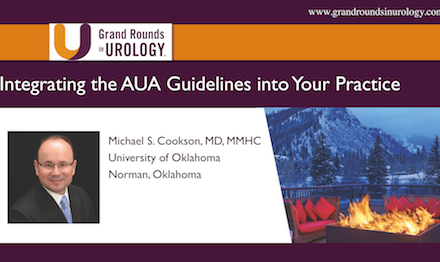Timing and Optimization of Radium 223 in CRPC
How to cite: Koo, Phillip J. “Timing and Optimization of Radium 223 in Castration Resistant Prostate Cancer” November 12, 2017. Accessed Apr 2024. https://dev.grandroundsinurology.com/timing-and-optimization-of-radium-223-in-crpc/
Summary:
Dr. Phillip J. Koo, MD, discusses the appropriate timing of radium 223 treatments in castration resistant prostate cancer patients, the best approaches to therapeutic layering, and the importance of recognizing bone metastasis when making these therapeutic decisions.
Timing and Optimization of Radium 223 in Castration Resistant Prostate Cancer
Transcript:
All right, so my disclosures.
All right, the optimal time to give radium-223 is; A. pre-chemo, B. post-chemo, or C. never?
All right, so the objectives. We’re going to talk about the significance of bone mets. We’re going to talk about the symptoms associated with bone mets. We’re going to talk a little about early identification, but Dr. Crawford already talked about that. We’ll briefly talk about therapeutic layering because he already addressed that, and we’re going to get into a little bit more of the details with regards to progression when it comes to radium-223 therapy.
All right, so advanced prostate cancer I don’t need to be telling you all of this, but it’s a disease that presides, resides predominantly in the bones. Malignant cells are widely disseminated in advanced prostate cancer, and you’ve seen those bone scans or any scan that shows that, that it’s really widespread and involves the bones. Typically we see red marrow bones being most involved, and that includes spine, pelvis, and ribs, and it probably has something to do with blood flow and just nutrients, metabolism, and whatnot. But they also occur in the skull and long bones as well, and we’ll occasionally see acrometastases in the fingers or feet or whatnot, but again mostly in the axial and proximal appendicular skeleton.
So, we know that prostate cancer has an affinity to bone, and I think the hypothesis or what we think is the bone matrix is rich in factors that stimulate the growth of tumor cells, and promotes a vicious cycle of metastases and bone pathology.
So, it’s this whole idea of homeland, you know, they migrate to a hostland and again there are a lot of these exosomes and other factors that really allows the bone to be a happy place for these prostate cancer cells.
This is an interesting study, and it was published in Nature in 2015 that talked about the different migratory pathways of bone mets. Mets usually spread between distant sites rather than as separate waves from the primary tumor, and that’s what’s pretty interesting.
Tumor cells sharing a common heritage travel from one site to another, and they retain their genetic imprint. And this whole idea supports a seed and soil theory about subclones developing the potential to metastasize. So, if you look at these different colors you see where they originate from, and again not everything comes from the primary prostate. It can come from other bone lesions and whatnot. So, I think this idea leads to the idea that maybe we should be treating the bones a little earlier to prevent this from seeding other places.
This is what we also know, is we know that disease tends to get more aggressive and worse as you go from lymph nodes to bone to visceral disease, and then bone plus visceral disease. You know? So, yeah, I guess visceral disease is something that we are always very fearful of, and something that we know at that point the disease is much more aggressive.
All right, what we also know is the fact that multiple symptoms are associated with bone mets, and we’ve heard about this a little earlier, but I think we really need to expand our thoughts of symptoms beyond just bone pain. And what we actually see, and this I think comes from a survey that Dr. Shore had completed, is that fatigue is actually the most stressful symptom in which patients with mCRPC complain about, but we see a lot of other symptoms; interference with sleep, dyspnea, impaired mobility, difficulties doing their daily activities, and even from my own personal experience a lot of these patients come in and I don’t know if it’s a machismo thing but they just don’t want to say it’s pain. You know? But we do realize that there are other ways in which prostate cancer affects our patients besides pain. And if we wait for pain it’s too late.
Nearly 7 to 10 patients ignore their symptoms, so healthcare professionals need to focus on and be more proactive with discussing symptoms because symptoms are typically being underreported.
The most common symptoms in our patients with advanced prostate cancer include fatigue, the body pain or aches, numbness or weakness, difficulty sleeping, difficulty doing normal activities, anxiety, vomiting, and loss of appetite.
We talked about this; you know, I think this is important, and when we first developed this it was based on bone scans and CT, but now we have better imaging, so I think there’s no question we will be detecting metastatic disease sooner. But I think it’s up to all of us to be looking and finding the best strategy for your own practice to detect metastatic disease.
And again, it leads to this idea of layering.
And we saw this, but so just quickly, just the idea of layering things on top of each other I think.
And really it goes back to the whole idea of finding the right patient and treating them at the right time. So, we have patients with bone mets and we have to identify those bone mets, and we also then have to identify the signs and symptoms, and again, expand our perception of symptomatology beyond just pain to include things like fatigue, impaired mobility, etcetera. And then layer radium-223 on top of the second-generation androgen inhibitor when PSA rises. And as we heard from Drs. Crawford and Bryce I still see that a lot of time where a patient will be on abi and then switch to enzalutamide when we know that doesn’t work. You know? So, the idea here is to then all right, if the patient is on a second generation, their PSA goes up, you know, think about radium at that point, if they have symptomatic bone metastases, again, that’s the key, symptomatic bone mets.
Once you make the decision to start I think it’s important that we stay with this idea of completing therapy. And this comes from Dr. Sartor. He presented this at ASCO in 2015 that he found that patients with less prior therapy had a greater chance of completing more cycles. And the clinical parameters which reflect early disease stage were associated with more likelihood of completing therapy. And this comes from the Farber and talks about concurrent abi and previous sip-T as being associated with patients receiving all five to six therapies. This is likely because they are earlier in their disease course.
Why is that important? It’s important because the data that we’re seeing so far from the expanded access trials and other studies, and this was presented at ASCO 2015 and published in the European Journal of Nuclear Medicine in 2015 is that total radium cycles, and abi in this one study, were associated with improved overall survival and improved progression free survival, and improved bone event-free survival.
There was higher mortality in patients in the group of patients receiving less than five doses versus those who received greater than five doses. So, for those of you who aren’t familiar, when we start this it’s supposed to be six total doses every four weeks. So, it’s actually a total of five months. So, it’s very important for patients to get to at least five, and ideally six of these therapies.
So, I tell this to all of the patients when they start, you know, we’re here and we’re committed. We need to commit to finishing, but obviously we want to make sure we’re safe throughout that whole process.
Imaging, you know, I think is very important in this idea of progression, but I think we also need to be careful, and a lot of times we think, you know, obviously radiology we think imaging is everything, but it’s really not. I think it only tells a part of the story.
So, it’s one way to assess for progression, not the only way. And that’s why when Dr. Crawford was talking about the RADAR II recommendations it made a lot of sense that we included more than just imaging, you know, convincing, consistent rise in PSA, radiographic progression, and clinical symptoms while on therapy. And I think it’s hard just to take one of these and say hey this patient is progressing. And it really takes the art of medicine for physicians and advanced practice providers to assess this and not rely on just one bone scan or one CT as progression.
These are the APPC recommendations from the St. Gallen convention in March of 2017, this year. And it provides sort of a guideline with regards to how you should manage your patients who are getting radium-223. And at each visit it makes sense that you would want to assess their clinical symptoms. You actually want to also assess total alkaline phosphatase at every visit. And what we’re seeing from data from the ALSYMPCA trial, and the expanded access trial is that alkaline phosphatase is probably a better biomarker for patients’ response and their prognosis while undergoing radium-223 therapy.
LDH is another secondary marker. Personally we don’t use that too often, but if there’s ever a discordance between some of the different biomarkers LDH might help as well.
You’re obviously going to want to check the hematologic parameters every month. So, we tend to require a CBC seven days of their scheduled therapy. And patients at baseline they need platelets greater than 100,000, ANC greater than 1.5, and a hemoglobin greater than 10. For doses two through six their hemoglobin does not matter. They need an ANC of greater than 1, and platelets greater than 50. So, the actual requirements for the subsequent doses actually go down in terms of your platelets and your ANC values.
PSA, so PSA we routinely check at baseline, and they recommend this too, and they check it at follow up. I think the idea of checking a PSA in between is kind of optional. And I think it’s because we know that PSA is going up. I think if we, if you’re aware of what this PSA does while on this therapy I think it’s safe to go ahead and get a PSA. I think there is some value to a PSA in the sense that if it really rises rapidly it might give you some pause and time to think about maybe is this patient progressing in other ways? Are they having, do they have new visceral metastases? But again, that’s really up to your own practice how you want to track these. But again, a rise in PSA is something we expect.
So, imaging; typically we’ll do imaging at baseline, and this is what they recommend as well, and we’ll do it in follow up, and follow up CT scan here is optional according to the APPC guidelines.
Patients, you know, when we first started we used to do bone scans and CTs after their third dose, but what we found was that it really wasn’t very helpful. A lot of these patients their bone scan after three cycles looked a little worse, and the question was was that flare? Was it just the bony response to the disease being treated? Which is a good thing. And we know that flare is a good thing in many cases. Or was it real progression? And I think it created a lot of anxiety in physicians and in patients. So, personally I just don’t think it’s worth the added money, the added time to get a bone scan in between.
CT scan as well, you know, if the patient is cruising along, feels great, you know, I don’t think there’s a reason to get a PSA. I mean we’ve had some patients with remarkable responses. The first patient we treated in Colorado was literally hitting golf balls that afternoon, when he had never played golf in the past three months. We had another patient recently who came in in a wheelchair and left, and bought a Harley after his third cycle. So, that was our own biomarker that he was healthy, healthier not healthy. But again, those types of responses aren’t the norm.
But again, so for CT scans I personally think it’s more valuable to assess the patient, seen how they’re doing. If there is a clinical concern that the patient developed visceral metastatic disease during that time yeah, then a CT scan with contrast is absolutely indicated.
Changes in management, you know, we heard about this but it’s important to reiterate the fact that we need to be aware of the different mechanism of action, and understand why we’re doing things and what their options are. So, if they do have PSA progression think about it, you know, re-image as you feel necessary, and then alter and layer as you feel necessary.
So, in summary, it’s real important to identify the right patient, and that includes looking for metastatic disease, and number two doing a thorough history to evaluate symptomatology. And it’s pretty ironic that a radiologist is talking about thorough histories, but I apologize. And then layer at the right time. And then lastly, when you start on this path just commit if possible to getting five to six because I think one of the things that’s always a shame is for a patient to start down this course, only make it to three, two, three, four doses, and then fall out. Personally, if we have a patient who looks that sick and we don’t think they’re going to get to five or six. I mean the question is do we even start? So, I think that’s something to think about. But if we’re thinking this a little earlier in disease and layering it on top when the PSA rises while they’re on a second-generation antiandrogen I think the chances of finishing five to six go up much higher.
All right, optimal time to give radium-223 is? All right, great. Thank you.






